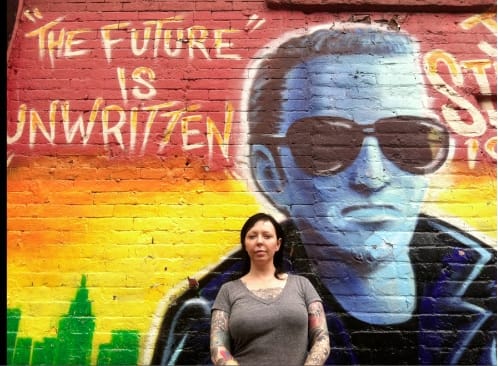I love the video for Joe Strummer’s cover of “Redemption Song.” (Click here to watch it in a new window.) Created after his death, the video captures the spray painting of a mural on the corner of 7th Street and Avenue A in New York’s East Village.
Joe himself wasn’t Buddhist, but I still find so many things about his nature and ethos that match Buddhist teachings.
The video opens with Joe’s voice, a gravelly, thoughtful voice: “I’d like to say that people, people can change anything they want to. And that means everything in the world. …It’s time to take humanity back into the center of the ring, and follow that for a time. Ya know, think on that, without people you’re nothing.”
The fact that this video was done posthumously, in itself, is a reflection on mehthaba, or impermanence. For years I lived in this neighborhood, and mused that this mural, in particular, had not succumbed to tags, or other graffiti; it seemed to have an air of permanence, that it was respected. But I was aware, that with the winds, and rain, and snow, it would eventually begin to chip and flake.
It’s not hard to draw a Buddhist feel from Joe’s spoken words; it is a genuine reflection on the vastness of “other”: peoples’ inherent desire for change, to change for the better, and the ego-crushing interdependent fact, “without people you’re nothing.” Even his call to “follow” the thought, “It’s time to take humanity back into the center of the ring, and follow that for a time” – if all people were able to meditate on the concept of humanity, keep it present and center in their mind, to abide with that feeling, and follow it… just imagine the result.
The song begins, and the mural on the wall begins to take shape.
Won’t you help to sing these songs of freedom, cuz all I ever had, redemption songs, these songs of freedom…
The concept of “Freedom Songs” is one that resonates with me personally from a human rights standpoint. In fact, one night in India, a group of young Tibet activists and myself sat out on the patio late one night. My laptop was playing this video, and one friend brought out his guitar; within minutes, we were playing and singing along. Perhaps that’s my own personal attachment. But “freedom songs,” to me, represent prayer – thinking of the lilting patterns of pujas, these are songs for liberation. Tara’s mantra, Om Tare Tuttare Ture Soha, is a freedom song – a call to be released from sorrow, to be liberated, and to gain merit for future rebirths.
Emancipate yourselves from mental slavery, none but ourselves can free our minds.
Mental slavery is indeed that, with so many of our problems originating in our mind — we are a slave to our thoughts. Medicine, money, friends – these can not free our minds. Buddhism gives us the tools and the means, but none but ourselves can apply them. This lyric seems to read like an advertisement for Buddhism: “Eliminate Samsara now!”
I digress. Time to get back to why the video, instead of just a song. The mural comes together on an East Village corner that is seeing its better days; the elements that most of society doesn’t want on its doorstep have been shuffled off in favor of gentrification. But the spraypaint itself to me is iconic. As I mentioned before, I’m boggled by the respect that has been shown for this mural, but that brings me back to the culture of graffiti. It’s an art form that is considered dirty, an urban plague – all the neighborhood hardware stores have their spraypaint locked up in cages, as if the cans themselves are criminal.
Yet, that “dirty” paint is used to create this beautiful painting, and this uplifting image develops. You see the awe of those watching its creation, there are clips of Joe on stage, images of the faces coming together, singing the words, and unified in dance. The final painting is finished when the words “The Future is Unwritten” are written across the bottom. Nothing could be closer to the truth.
Similar to a lotus that grows from the dark depths, this mural remains untouched; an image of a man who questioned everything and encouraged others too as well. I’ll leave this with one of my favorite Strummer statements:
“The way you get a better world is, you don’t put up with substandard anything.”

